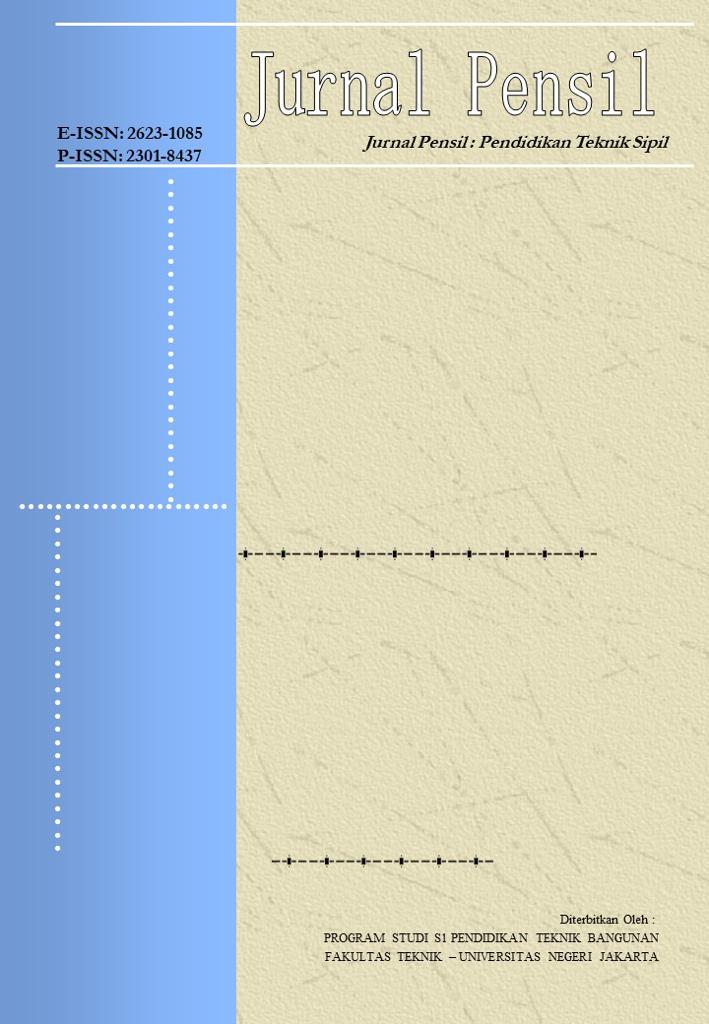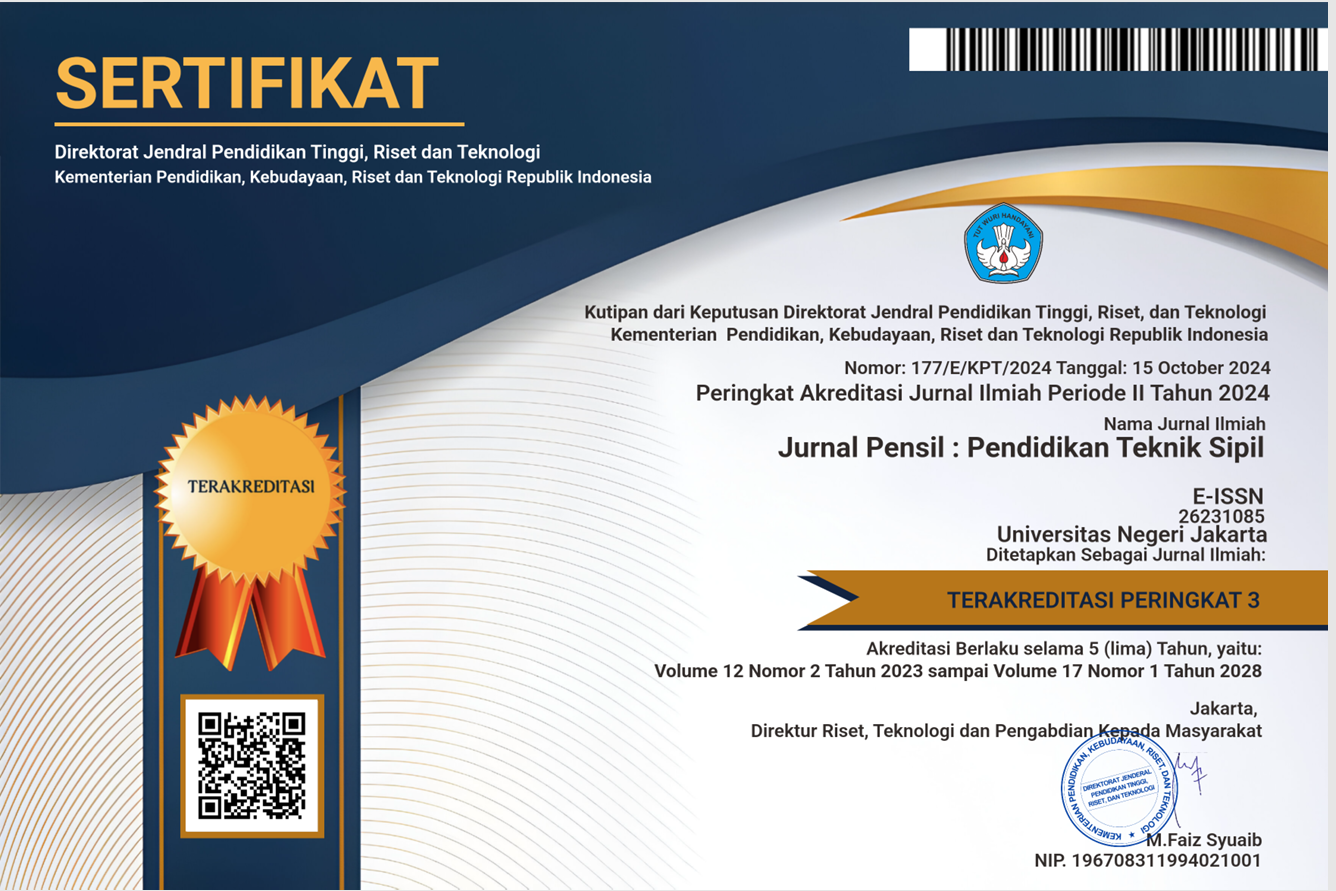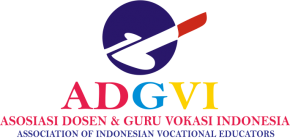OVERVIEW OF UNDERSTANDING AND PREPAREDNESS FOR EARTHQUAKES IN THE PERSPECTIVE OF VOCATIONAL HIGH SCHOOL STUDENTS
DOI:
https://doi.org/10.21009/jpensil.v13i1.38104Keywords:
Earthquake Disasters, Preparedness, Disaster Mitigation, Knowledge, Vocational High School StudentsAbstract
Knowledge of disaster mitigation is the most essential component and a key factor for preparedness. The possessed knowledge typically influences attitudes and concerns, fostering readiness to anticipate disasters. Vocational High School students should be informed about the various disasters that frequently occur in their areas, as well as the procedures to face sudden disasters. The significant loss of lives and various damages to buildings and facilities in the vicinity underscore the need for a deeper examination of mitigation efforts. The objective of this study is to assess the level of understanding and preparedness of Vocational High School students regarding earthquake natural disasters. The research method employed is quantitative, with descriptive statistics as the analytical technique. The instruments used include test instruments and non-test instruments utilizing Google Forms to collect data from several Vocational High Schools in various cities in DKI Jakarta, Sukabumi, and Tangerang. The research findings reveal that 42% of students are unaware of earthquake disaster mitigation measures. Additionally, 69% of students lack knowledge about minimizing damage from earthquakes in terms of building construction. Furthermore, 65% of students are unfamiliar with images related to earthquake-resistant construction. Moreover, 52% of students still do not know the local earthquake resilience features of earthquake-resistant houses. Lastly, 52% exhibit a panicky attitude, hastily evacuating buildings during an earthquake. The conclusion drawn from this research is that the knowledge of Vocational High School students regarding earthquake disasters and their mitigation measures is still low.
References
Adiyoso, W. (2018). Manajemen bencana: Pengantar dan isu-isu strategis. Bumi Aksara.
Aguirre, J., De La Torre, U, D., Bazo, J., Quequezana, P., & Collado, M. (2019). Evaluation of Early Action Mechanisms in Peru Regarding Preparedness for El-Nino. International Journal Disaster Risk Science, 10, 493–510. https://doi.org/https://doi.org/10.1007/s13753-019-00245-x
Alam, E. (2016). Earthquake and Tsunami Knowledge, Risk Perception and Preparedness in The SE Bangladesh. Ournal Geography Nature Disasters. https://doi.org/https://doi.org/10.4172/2167-0587.1000154
Ali, Z., Qaisar, M., Mahmood, T., Shah, M, A., Iqbal, T., Serva, L., Michetti, A, M., & Burton, P, W. (2009). The Muzaffarabad, Pakistan, Earthquake of 8 October 2005: Surface Faulting, Environmental Effects and Macroseismic Intensity. Geol Soc Lond, Spec Public, 1, 155–172. https://doi.org/https://doi.org/10.1144/sp316.9.
Aryana, D. (2021). Modul Ajar Mitigasi Bencana Gempa Bumi Projek IPAS. Direktorat Sekolah Menengah Kejuruan. Direktorat Jenderal Pendidikan Vokasi. Kementerian Pendidikan, Kebudayaan, Riset dan Teknologi.
Bansal, B, K., & Verma, M. (2012). Education and Awareness: A Key to Earthquake Risk Reduction. Ournal Geology Social India, 80, 451–454. https://doi.org/https://doi.org/10.1007/s12594-012-0164-2
Bansal, B, K., & Verma, M. (2108). Earthquake Precursory Studies in India: An Integrated Approach. In Handbook on Natural Hazards: Earthquake, Volcanoes and Landslide. Taylor & Francis.
Bansal, B, K., Verma, M., Gupta, A, K., & Prasath, R, A. (2022). On Mitigation of Earthquake and Landslide Hazards in The Eastern Himalayan Region. Natural Hazards, 114, 1079–1102. https://doi.org/https://doi.org/10.1007/s11069-022-05448-y
Barua, U., Mannan, S., Islam, I., Akther, M. S., Islam, M. A., Akter, T., Ahsan, R., & Ansary, M. A. (2020). People’s awareness, knowledge and perception influencing earthquake vulnerability of a community: A study on Ward no. 14, Mymensingh Municipality, Bangladesh. In Natural Hazards (Vol. 103, Issue 1). Springer Netherlands. https://doi.org/10.1007/s11069-020-04028-2
Bwambale, B. (2020). Questioning Knowledge Fondation: What is the Best Way to Integrate Knowledge to Achieve Substantial Disaster Risk Reduction ? International Journal of Disaster Risk Reduction, 20, 1–29. https://doi.org/https://doi.org/10.1016/j.ijdrr.2020.101850
Cefalu, C, A. (2014). Disaster Preparedness for Seniors: A Comprehensive Guide for Healthycare Professionals. Springer Publisher. https://doi.org/10.1007/978-1-4939-0665-9
Choudhury, M., Verma, S., & Saha, P. (2016). Effects of Earthquake on The Surrounding Environment: An Overview. Proceedings of International Conference on Recent Advances in Mechanics and Materials (ICRAMM.
Coll, Melisa, A., Merelo, Francisco, B., Peiro, Marcos, M., & Franco, Emiro, D. la H. (2018). Real-Time Early Warning System Design for Pluvial Flash Floods-A Review. Sensors, 18, 1–26. https://doi.org/10.3390/s18072255
Djawad, Y. A., Jaya, H., Saliruddin, S., & Supriadi, S. (2019). PEMBERDAYAAN SISWA SMK MELALUI PELATIHAN PENERAPAN ALAT DETEKSI BANJIR BERBASIS IoT DI KAB. BULUKUMBA MELALUI PROGRAM KKN PPM. Jurnal MEKOM (Media Komunikasi Pendidikan Kejuruan), 6(2), 101. https://doi.org/10.26858/mekom.v6i2.13839
Elbaz, K., Shen, S, L., Arulrajah, A., & Horpibulsuk, S. (2016). Geohazards Induced by Anthropic Activities of Geoconstruction: A Review of Recent Failure Cases. Arab Journal Geoscience, 9(708). https://doi.org/https://doi.org/10.1007/s12517-016-2740-z.
Elliott, J. R. (2020). Earth Observation for the Assessment of Earthquake Hazard, Risk and Disaster Management. In Surveys in Geophysics (Vol. 41, Issue 6). Springer Netherlands. https://doi.org/10.1007/s10712-020-09606-4
Goda, K., Kiyotaka, T., Pokhrel, R, M., Chiaro, G., Katagiri, T., Sharma, K., & Wilkinson, S. (2015). The 2015 Gorkha Nepal Earthquake: Insight From Earthquake Damage Survey. Front Build Environment., 1(8). https://doi.org/https://doi.org/10.3389/fbuil.2015.00008
Gupta, H, K., Sabnis, K, A., Duarah, R., Saxena, R, S., & Baruah, S. (2020). Himalayan Earthquakes and Developing an Earthquake Resilience Society. Journal Geology Social India., 96(5), 433–446. https://doi.org/https://doi.org/10.1007/s12594-020-1581-2
Guzetti, F., Gariano, S, L., & Peruccacci, S. (2020). Geographical Landslide Early Warning Systems. Earth Science Review, 200. https://doi.org/https://doi.org/10.1016/j.earscirev.2019.102973
Hamit, I., Saputra, A., & Siswanto, M. F. (2023). the Effectiveness of the Rehabilitation and Reconstruction Program for Post-Earthquake Community Houses in North Lombok Regency in 2018. Jurnal PenSil, 12(3), 322–336. https://doi.org/10.21009/jpensil.v12i3.35114
Hashim, Hajar, M., Ng, Yee, G., Talib, O., & Tamrin, Shamsul, Bahri, M. (2021). Factors influencing flood disaster preparedness initiatives among small and medium enterprises located at flood-prone area. International Journal of Disaster Risk Reduction, 60, 1–8. https://doi.org/https://doi.org/10.1016/j.ijdrr.2021.102302
Hayudityas, B. (2020). PENTINGNYA PENERAPAN PENDIDIKAN MITIGASI BENCANA DI SEKOLAH UNTUK MENGETAHUI KESIAPSIAGAAN PESERTA DIDIK. Edukasi Non Formal, 4(1), 94–102.
Hussain, E., Elliot, J, R., Silva, V., Vilar, V, M., & Kane, D. (2020). Constrasting Seismic Risk for Santiago, Chile, From Near-Field and Distant Earthquake Sources. Nature Hazards Earth Syst Sci, 20, 1533–1555. https://doi.org/https://doi.org/10.5194/nhess-20-1533-2020
Ichsan, I. Z., Rahmayanti, H., Purwanto, A., Sigit, D. V., Kurniawan, E., Dewi, A. K., Wirdianti, N., Hermawati, F. M., & Marhento, G. (2020). PEMBELAJARAN SAINS DAN LINGKUNGAN DI SMP yang berisi himbauan kepada masyarakat untuk melakukan Physical Distancing ( menjaga. E- Journal UMM, 6, 50–61.
Ilyasa, F. (2023). engembangan Media Pembelajaran Berbasis Digital Terhadap Peningkatan Pengetahuan dan Kesiapsiagaan Mitigasi Bencana Banjir Rob di Muara Angke. Universitas Negeri Jakarta.
Indarta, Y., Jalinus, N., Waskito, W., Samala, A. D., Riyanda, A. R., & Adi, N. H. (2022). Relevansi Kurikulum Merdeka Belajar dengan Model Pembelajaran Abad 21 dalam Perkembangan Era Society 5.0. Edukatif : Jurnal Ilmu Pendidikan, 4(2), 3011–3024. https://doi.org/10.31004/edukatif.v4i2.2589
Jimee, G, K., Upadhyay, B., & Shrestha, S, N. (2012). Earthquake Awareness Programs as a Key for Earthquake Preparedness and Risk Reduction: Lessons from Nepal. The 14th World Conference on Earthquake Engineering.
Jolivet, R., & Frank, W, B. (2020). The Transient and Intermittent Nature of Slow Slip. AGU Advance, 1(1). https://doi.org/https://doi.org/10.1029/2019AV000126
Kreemer, C., Blewitt, G., & Klein, E, C. (2014). A Geodetic Plate Motion and Global Strain Rate Model. Geochem Geophys Geosyst, 15(10), 3849–3889. https://doi.org/https://doi.org/10.1002/2014GC005407
Liu, M., Wang, L., Shi, Z., Zhang, Z., Zhang, K., & Shen, J. (2011). Mental Health Problems Among Children One-Year After Sichuan Earthquake in China: A Follow-Up Study. PLoS One, 6(2). https://doi.org/https://doi.org/10.1371/journal,pone.0014706
Mulyati, S. (2022). Jurnal Basicedu. Jurnal Basicedu, 6(2), 2495–2504.
Noviana, E., Kurniawan, O., Munjiatun, Sismulyasih, N, S., & Nirmala, S, D. (2019). Why Do Primary School Students Need Disaster Mitigation Knowledge ?: Study Of The Use Of Koase Comics in Primary Schools. International Journal of Scientific & Technology Research, 8(11), 216–221.
O’Mathuna, D. P., & Dranseika, V. (2018). Disasters: Core Concepts and Ethical Theories (B. Gordjin (ed.)). Springer. https://doi.org/https://doi.org/10.1007/978-3-319-92722-0
Prihantini, A., Rahmayanti, H., & Samadi, S. (2022). the Effect of Preparedness Measures on Community Participation in Flood Emergency Response in Rangkasbitung District. Jurnal PenSil, 11(3), 231–241. https://doi.org/10.21009/jpensil.v11i3.28423
Rosida, F., & Adi, K. R. (2017). Studi Eksplorasi Pengetahuan Dan Sikap Terhadap Kesiapsiagaan Bencana Banjir Di SD Pilanggede Kecamatan Balen Kabupaten Bojonegoro. Jurnal Teori Dan Praksis Pembelajaran IPS, 2(1), 1–5. https://doi.org/10.17977/um022v2i12017p001
Sadeka, S., Mohamad, Mohd, S., Reza, Mohammad, Imam, H., Manap, J., & Sarkar, Md, Sujahangir, K. (2015). Social Capital and Disaster Preparedness: Conceptual Framework and Linkage. International Conference on Social Science Research, 178–188. https://doi.org/10.13140/RG.2.1.2664.9767
Setyowati, Dewi, L. (2019). Pendidikan Kebencanaan. Universitas Negeri Semarang.
Shi, M., Xu, W., Gao, L., Kang, Z., Ning, N., Liu, C., & Liang, L. (2018). Emergency Volunteering Willingness and Participation: A Cross-Sectional Survey of Residents in Northern China. BMJ Open, 8(7).
Spiekermann, R., Kienberger, S., Norton, J., Fernando, B., & Weichselgartner, J. (2015). The Disaster-Knowledge Matrix-Reframing and Evaluating the knowledge challenges in disaster risk reduction. International Journal of Disaster Risk Reduction, 13, 96–108. https://doi.org/http://dx.doi.org/10.1016/j.ijdrr.2015.05.002
Sudaryono. (2018). Metodologi Penelitian: Kuantitatif, Kualitatif dan Mix Method (Cetakan 2). PT RAJAGRAFINDO PERSADA.
Sugiyono. (2016). Metode Penelitian Kuantitatif, Kualitatif, Dan R&D. Alfabeta, cv.
SUPRIANI, F. (2009). Studi Mitigasi Gempa Di Bengkulu Dengan Membangun Rumah Tahan Gempa. Inersia: Jurnal Teknik Sipil, 1(1), 8–15.
Sutton, J., & Tierney, K. (2006). Disaster Preparedness: Concepts, Guidance and Research. Report Prepared for the Fritz Institute Assessing Disaster Preparedness Conference, 1–27.
Thoha, M. (2017). Edukasi sadar bencana melalui sosialisasi kebencanaan sebagai upaya peningkatan pengetahuan siswa terhadap mitigasi bencana. Jurnal Pendidikan Ilmu Sosial, 29(1), 49–55.
Wallace, L, M., Webb, S, C., Ito, Y., Mochizuki, K., Hino, R., Henrys, S., Schwartz, S, Y., & Sheehan, A, F. (2016). Slow Slip Near The Trench at The Hikurangi Subduction Zone. New Zealand. Science, 352(6286), 701–704. https://doi.org/https://doi.org/10.1126/science.aaf2349
Wibowo, N. (2016). Upaya Memperkecil Kesenjangan Kompetensi Lulusan Sekolah Menengah Kejuruan dengan Tuntutan Dunia Industri. Jurnal Pendidikan Teknologi Dan Kejuruan, 23(1), 45. https://doi.org/10.21831/jptk.v23i1.9354
Wyss, M., Gupta, S., & Rosset, P. (2017). Casualty Estimates in Two Up-Dip Complementary Himalayan Earthquakes. Sesimol Res Lett, 88(6), 1508–1515. https://doi.org/https://doi.org/10.1785/0220170091
Yokomatsu, M., & Hochrainer, S. (2020). Disaster Risk Reduction and Resilience (Stigler (ed.)). Springer. https://doi.org/https://doi.org/10.1007/978-981-15-4320-3












.png)
.png)
1.png)

